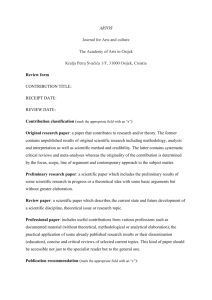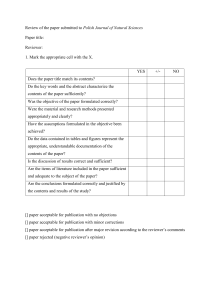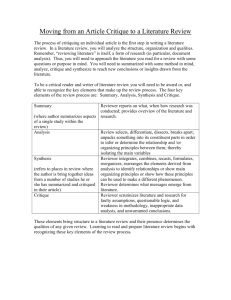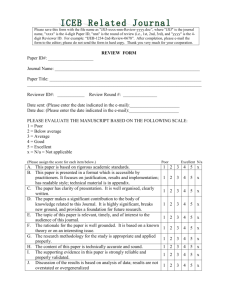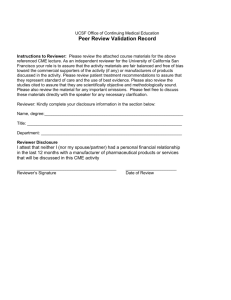Incidental Mood and Consumer Evaluation of Price Attractiveness:
advertisement
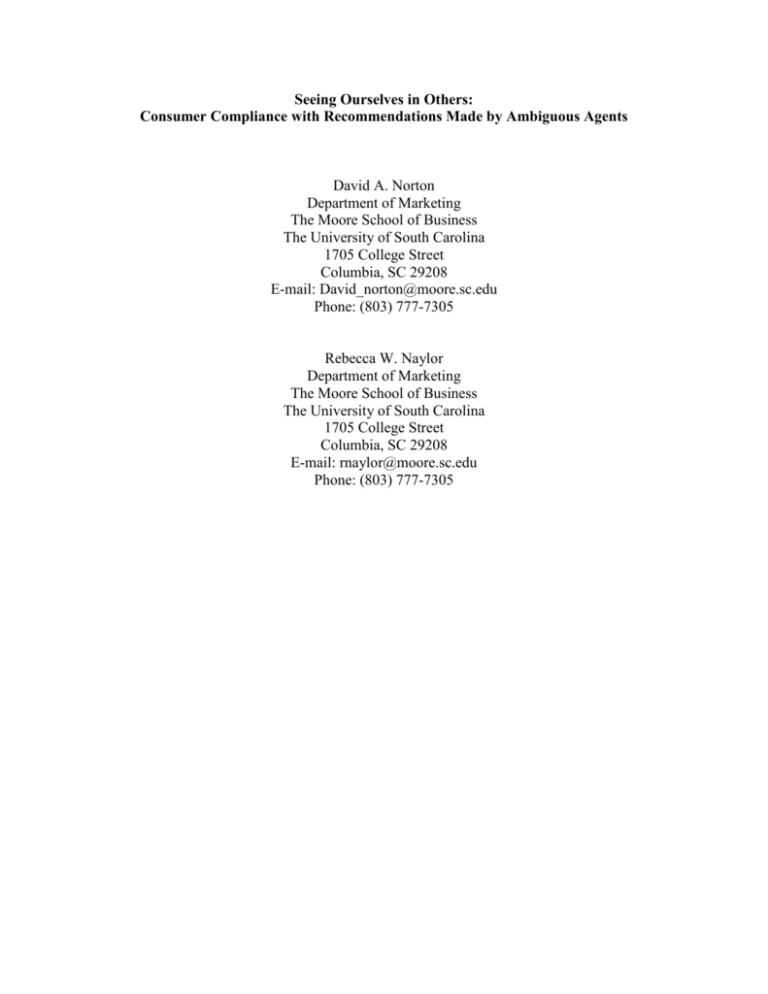
Seeing Ourselves in Others: Consumer Compliance with Recommendations Made by Ambiguous Agents David A. Norton Department of Marketing The Moore School of Business The University of South Carolina 1705 College Street Columbia, SC 29208 E-mail: David_norton@moore.sc.edu Phone: (803) 777-7305 Rebecca W. Naylor Department of Marketing The Moore School of Business The University of South Carolina 1705 College Street Columbia, SC 29208 E-mail: rnaylor@moore.sc.edu Phone: (803) 777-7305 This research investigates how compliance with a recommendation made by another consumer is affected by the amount of information provided about the reviewer and the perceived similarity of the reviewer. In Study 1 we demonstrate that, given no information about a reviewer (i.e., the reviewer’s characteristics are ambiguous), consumers project their own characteristics onto the reviewer, resulting in compliance likelihoods that are similar to compliance with a recommendation made by a reviewer presented as similar (vs. dissimilar) to the target consumer. In Study 2 we demonstrate that the false consensus effect is responsible for these results. Consumers seeking recommendations on products and services have typically obtained this information from two primary sources, professional agents who are paid to make such recommendations (e.g., movie critics, interior decorators) (Solomon 1986; West 1996) or friends and family members who provide this information through word-of-mouth communication (Brown and Reingen 1987). However, Internet technology now offers consumers a new source for product information: consumer-to-consumer recommendations in which no personal information is provided about the reviewer (e.g., online user reviews that are posted with no identifying information about the reviewer other than a user name). The primary research question we seek to address is: how do consumers respond to recommendations made by an ambiguous reviewer (whom we define as a reviewer about whom no personal information is available)? Previous research on agent recommendations suggests that giving consumers more information about a product recommender will increase compliance with the recommendation if that recommender is demographically similar to the consumer (Feick and Higie 1992). Gershoff and Johar (2006) demonstrate, for example, that consumers overestimate an agent’s knowledge based on over-reliance on similarity cues in a close relationship. Hence, past research suggests that reviewer ambiguity would decrease compliance with reviewer recommendations since consumers will be unsure whether the reviewer is similar (which would increase compliance) or dissimilar (which would decrease compliance) to themselves. However, Norton, Frost, and Ariely (2007) argue that ambiguity can be beneficial in some contexts (e.g., potential dating partners are liked more when people have less information about them because more information increases the likelihood of discovering dissimilarity between oneself and a potential partner). We propose that, when provided with no identifying information about a reviewer, consumers project their own characteristics onto that reviewer in a manner consistent with the false consensus effect (in which consumers tend to overestimate the prevalence of their own attitudes in the general population; Ross, Greene, and House 1977), such that consumers respond as positively to recommendations made by ambiguous reviewers as they do to recommendations by reviewers that they know are similar to themselves. Essentially, we propose that when information about reviewers’ tastes is left ambiguous, participants assume these reviewers share their own tastes and attitudes. To test our hypotheses, in Study 1 each participant read a restaurant review ostensibly written by another consumer and then indicated their intentions to visit the restaurant they read about. The review was designed to be slightly positive in order to make the restaurant attractive but to avoid ceiling effects.The text of the review was held constant across all conditions, and amount and type of reviewer information was manipulated such that participants saw either (1) no information about the reviewer (ambiguous reviewer condition), (2) information about a reviewer who was similar to the average student at their university (similar reviewer condition), or (3) information about a reviewer who was different from the average student at their university (dissimilar reviewer condition). In the similar and dissimilar reviewer conditions, the participants saw nine units of demographic information (e.g. age, gender, university attended, etc.) that were either similar or dissimilar to themselves (gender) or to the average student at their university (age, university attended). After reading the review, participants rated, on a scale of one (“not at all likely”) to nine (“extremely likely”), how likely they would be to try the restaurant. Participants also rated how similar they thought the reviewer was to themselves in terms of similarity in restaurant taste. In order to analyze the results of Study 1, we used orthogonal contrast codes comparing (1) the similar reviewer condition to the ambiguous reviewer condition and (2) the ambiguous and similar reviewer conditions to the dissimilar reviewer condition. We found, as predicted, that participants in the similar reviewer (M = 5.99) condition showed no difference in likelihood of trying the recommended restaurant compared to participants in the ambiguous reviewer condition (M = 6.00), F(1, 216) = 0.00, p > .95. However, compliance with the recommendation was significantly lower for the dissimilar reviewer condition (M = 5.37) compared to the similar and ambiguous reviewer conditions, F(1, 216) = 11.01, p < .01. In order to demonstrate that the differences we find in restaurant trial are indeed caused by differing perceptions of similarity, we compared participants’ ratings of similarity in the similar versus ambiguous reviewer conditions. As expected, participants perceived the reviewer in the ambiguous condition to be equally similar to themselves (M = 5.42) compared to the reviewer in the similar reviewer condition (M = 5.59), supporting our false consensus explanation. Further, the difference in perceived similarity between the dissimilar reviewer condition (M = 4.46) and the other two conditions mediated the relationship between the dissimilar versus similar and ambiguous reviewer conditions and likelihood of trying the restaurant, z = 3.93, p < .01. The goal of Study 2 was to provide additional evidence that these results are driven by the false consensus effect. We hypothesize that alerting participants to the potential bias of the effect (i.e., warning participants about the tendency to see oneself in ambiguous others) decreases compliance with an ambiguous reviewer’s recommendation. Hence, Study 2 used the same restaurant review context and three-level (ambiguous reviewer vs. similar reviewer vs. dissimilar reviewer) variable and added a two-level warning variable (such that participants were either warned about the false consensus effect or not warned). The results of Study 2 support our predictions; we found a significant interaction between the warning variable and the similar reviewer versus ambiguous reviewer contrast, F(1, 286) = 2.90, p < .01. With no warning about the false consensus effect, the results of Study 1 were replicated such that there was no difference in compliance with the recommendation between the similar and ambiguous reviewer information condition (M = 6.17 for both conditions). However, when participants received a warning about the potential impact of the false consensus effect, they were significantly less likely to try the restaurant in the ambiguous reviewer condition (M = 5.18) than in the similar reviewer (M = 6.35) condition, thus providing additional evidence that the false consensus effect drives our results. References Brown, Jacqueline Johnson and Peter H. Reingen (1987), “Social Ties and Word-of-Mouth Referral Behavior,” Journal of Consumer Research, 14 (December), 350–362. Feick, Lawrence and Robin A. Higie (1992), "The Effects of Preference Heterogeneity and Source Characteristics on Ad Processing and Judgments about Endorsers." Journal of Advertising, 21 (Summer), 9-24. Gershoff, Andrew D. and Gita Venkataramani Johar (2006), “Do You Know Me? Consumer Calibration of Friends’ Knowledge,” Journal of Consumer Research, 32 (March), 496503. Norton, Michael I., Jeana H. Frost, and Dan Ariely, “Less Is More: The Lure of Ambiguity, or Why Familiarity Breeds Contempt.” Journal of Personality and Social Psychology, Vol 92(1), Jan 2007. pp. 97-105. Ross, Lee, David Greene, and Pamela House (1977), “The False Consensus Effect: An Egocentric Bias in Social Perception and Attribution Processes,” Journal of Experimental Social Psychology, 13 (May), 279–301. Solomon, Michael R. (1986), “The Missing Link: Surrogate Consumers in the Marketing Chain,” Journal of Marketing, 50 (October), 208–218. West, Patricia M. (1996), “Predicting Preferences: An Examination of Agent Learning,” Journal of Consumer Research, 23 (June), 68–80.



